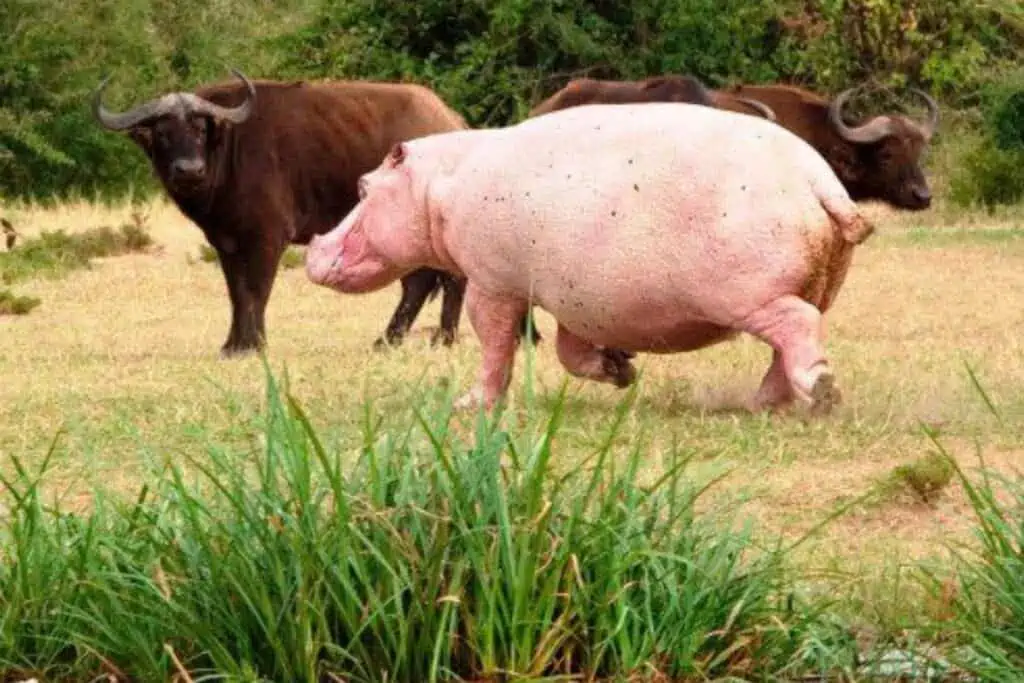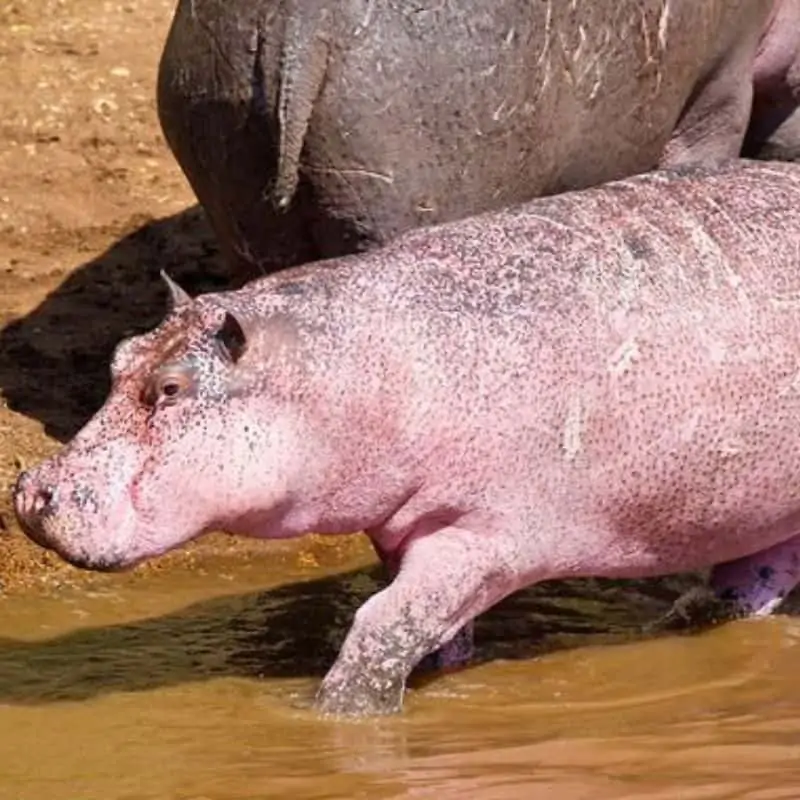When most people think of hippos, they imagine the large, gray creatures in Africa’s rivers and lakes. But there are other kinds of hippos, like pygmy hippos or even albino hippos and pink hippos, that few get to see.
The pink hippo and albino hippo are rare, with only a few found in Uganda. The pink hippo in Kenya suffers from leucism (a reduced pigmentation), not true albinism. Because of its rarity, the pink hippo is at higher risk of being poached by hunters.
This post will focus on hippo albinism and the pink hippo found in Kenya. So, without further ado, let’s get started.

Albino Hippo – Do They Really Exist?
Albinism is not common in hippos; there have only been a handful of recorded instances, mainly in Uganda, where albino hippos have been spotted.
At Gache Gache Lodge
Mike and Kent Davis spotted something unique at Gache Gache Lodge on Lake Kariba: an albino hippo.
This rare creature was only 15 months old when they saw him in 2014 living in the river nearby. They named him Ermintrude, but the lodge where they saw him has its own name for him: Chipolata.
At Queen Elizabeth National Park
Safari Guide Uganda (The Jungle boy) claims that Queen Elizabeth National Park at Kazinga Channel is home to a variety of albino species, including an Albino Hippo.
Is the Pink Hippo in Kenya an Albino?
The only pink hippo with darker eyes and some pigmented spots on its back spotted in Kenya is not a true Albino; it is actually leucistic, meaning it has reduced pigmentation.
Leucism can be contrasted with albinism, which is specifically caused by a reduction in melanin (skin pigment).
Leucism, on the other hand, causes animals and humans to have a reduced amount of all types of skin pigment.

Where Was the Pink Hippo Discovered?
In September, two English photographers, Matt and Will Burrard-Lucas, saw a young pink hippopotamus while taking pictures of the annual wildebeest migration near the Mara River in Kenya.
They stopped to have breakfast by the Mara River after a calm morning when they saw something incredible.
As they started to eat, they saw a pink hippopotamus come out of the river.
I can imagine the food falling from their mouths as they snapped away with their cameras.
6 Leucism-Related Facts About The Pink Hippo
Having leucism often comes with several challenges for an animal’s daily life. But there are always exceptions to the rule, and in this instance, it regards the pink hippo.
Below are some facts about this curious condition:
1. Unique Appearance
The pink hippo’s unique coloring is caused by leucism, not albinism. Leucism results in an overall reduced pigmentation of the skin, including melanin.
This makes the pink hippo the only available one of her kind in Kenya.
2. The Other Hippos Were Treating Pink Hippo Well
Creatures strikingly different often have harder lives; they frequently become outcasts, rejected by their conventionally colored peers.
In this case, however, Matt and Will Burrard-Lucas observed a pink hippo in a group of other hippos and noticed that the others didn’t treat it any differently.
3. Pink Hippo Was Found to be Very Shy
“The pale pink hippo was noticeably young due to its size; it was much tinier than the other hippos surrounding it. The juvenile hippo seemed very introverted and clung close to its mother’s side. To prevent startling it, we photograph from a distance using a 600mm lens. Nevertheless, it only stayed on land for several minutes before going back into the river where it felt more secure.” – On September 28, English brothers Will and Matt Burrard-Lucas wrote on their blog.
4. Consideration for the Pink Hippo Skin
Albinism and leucism are diseases that prevent the creation of natural pigments in the skin. This lifelong illness can cause light sensitivity, allergies, and susceptibility to sunburns and cancer.
However, this does not hold true for the pink hippo.
We know sweat excretion of hippos works as a fantastic sunscreen and protects them from harmful UV radiation… meaning this particular pink hippo should have no trouble surviving in the wild.
5. Pink Hippo Can Be Spotted Easily by Predators
Due to its atypical color for the species, the pink hippo is much easier to spot and, therefore, more vulnerable in the wild.
An animal’s coloring often provides camouflage from predators or prey. A leucitic creature without this skill would be a sitting target.
The pink hippo cannot take advantage of this protective measure (camouflage), making itself an easy target for attackers.
Fortunately, most predators can’t harm hippos because of their size, and this young hippo’s mother would fiercely protect it if they were ever attacked.
6. Pink Hippo Is at Greater Risk of Being Poached by Poachers
The real danger for the Pink hippo does not come from other animals but from humans seeking to exploit its rarity.
It is believed that the pink hippo may be targeted next because of its uniqueness in a country that is commonplace for hippo poaching for the sake of meat and ivory trade.
Hopefully, raising more awareness of this unique hippopotamus will bring about some protection for the rare pink hippo.
Final Thoughts on Albino Hippos
The pink hippopotamus, suffering from leucism, and not albinism, which causes reduced skin pigmentation, is a rare sight.
It was recently spotted near the Mara River in Kenya amongst other normal-colored hippos who didn’t hesitate to accept it into the group – even though it was shy and spent most of its time in the river where it felt more secure.
This pink hippo has leucism but shouldn’t have much trouble living in the wild due to natural sunscreen from sweating. However, since this hippo is very visible, it, unfortunately, becomes an easy target for poachers looking to exploit wildlife.
FAQs
Are There Pink Hippos?
Yes, as mentioned in the article, in September, two English photographers, Matt and Will Burrard-Lucas, saw a young pink hippopotamus while taking pictures of the annual wildebeest migration near the Mara River in Kenya.
Is the Albino Hippo a Rare Animal in Africa?
Albinism is so rare in hippos that only a handful of recorded instances exist. Most notably in Uganda, where a couple of albino hippos have been spotted. Mike and Kent Davis came across an albino hippo at Gache Gache Lodge on Lake Kariba. The hippo was only 15 months old at the time.
What’s the Difference Between Leucism and Albinism?
Albinism is specifically caused by a reduction in melanin (a type of skin pigment). Leucism, on the other hand, causes animals and humans to have a reduced amount of all types of skin pigment.
